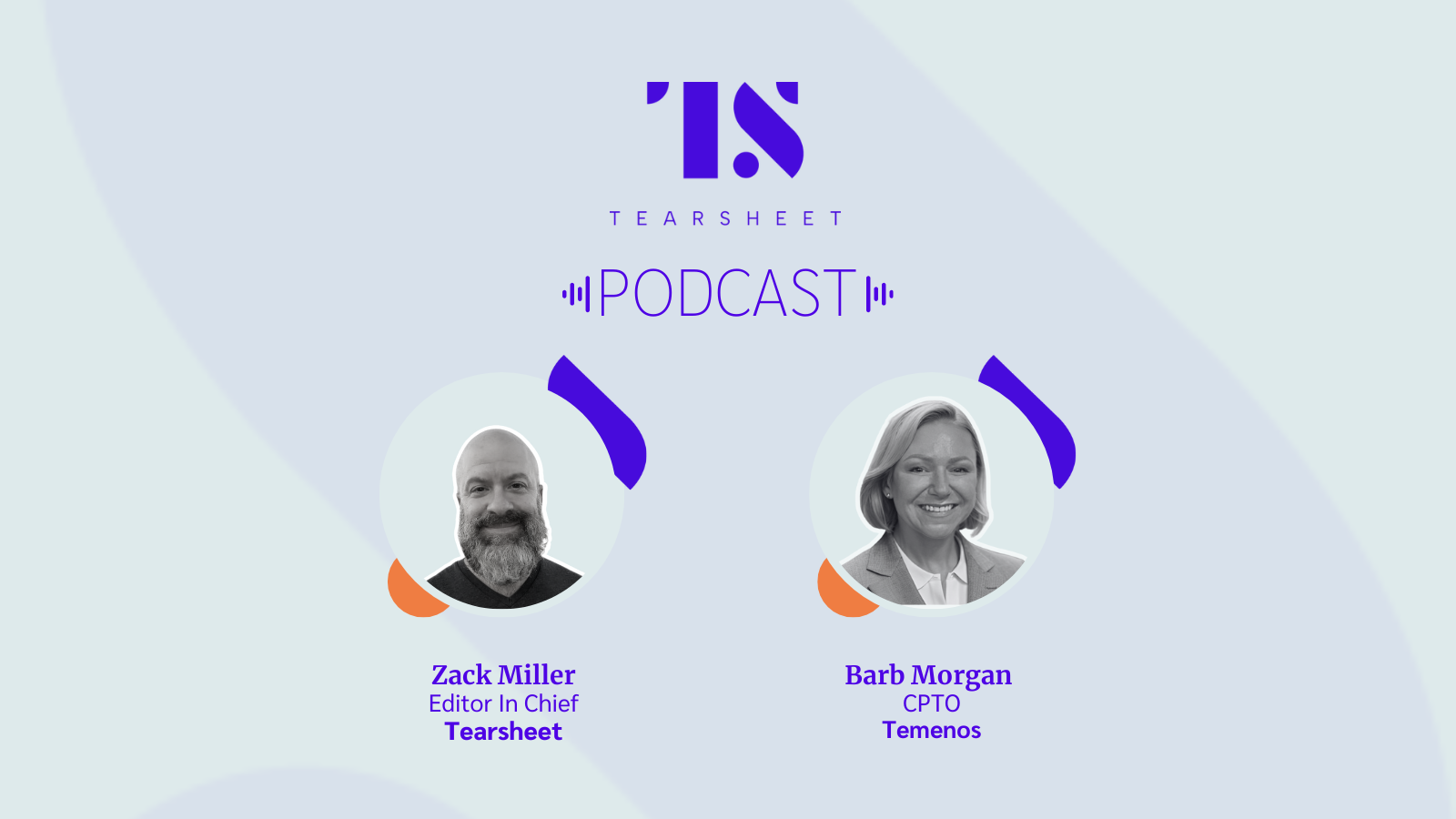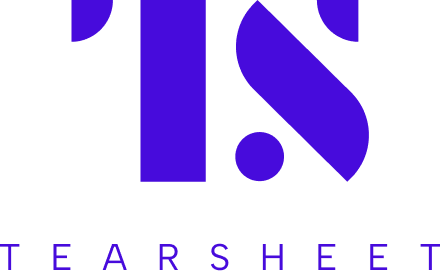Temenos CPTO Barb Morgan on measuring ROI, step by step modernization, and AI-enabled banking
- Temenos CPTO Barb Morgan reveals how financial institutions are shifting from viewing AI as just a chatbot solution to embracing it as a collaborative "side-by-side agent" that enhances human interactions while navigating complex regulatory requirements.
- The conversation delves into how banks are finding success with modernization by taking a modular approach rather than complete overhauls and how codesigning approaches aid in building more bank-centric products and processes.

Banks have a challenging time responding to technological leaps like AI primarily because of their compliance-comes-first approach. Financial institutions must also manage the technological debt of their legacy systems when approaching modernization.
On this episode of the Tearsheet Podcast, Temenos Chief Product and Technology Officer, Barb Morgan, offers a refreshing perspective on how financial institutions can embrace technology while maintaining their human touch. Her insights reveal how banks, particularly regional institutions, are balancing innovation with customer service and regulatory compliance.
Morgan’s approach emphasizes “augmented intelligence” over artificial intelligence, positioning AI as a collaborative tool for these firms. Her view of AI’s potential in this industry stems from her deep experience working with regional and large banks at Temenos, as well as her time at firms like FIS and Capital One.
The conversation highlights how Temenos is helping banks modernize at their own pace by offering flexible solutions that can be implemented module by module. It also dives into how these firms are measuring their ROI on modernization initiatives, a must-have in this market. Lastly, Barb shares how her firm partners with its banking clients to work on unique ideas.
Listen to full episode
Subscribe: Apple Podcasts I SoundCloud I Spotify
Industry Changes on the Horizon
Morgan predicts that AI-enhanced customer experiences will soon become standard. “Five years from now, [AI] will be the expectation,” she notes, adding that banks must move beyond simply wrapping digital interfaces around legacy systems to fully integrate their data for AI capabilities.
Data at the center
While many banks have focused on digital transformation, Morgan identifies data integration as the next critical step for institutions looking to leverage AI effectively and deliver modern CX. “As FIs improve the data… the positive outcome will be that they will be able to leverage data differently,” she shares, emphasizing how consolidated data systems will enable banks to better serve their customers and implement new processes and workflows enabled by AI.
Augmentation not replacement with AI
Morgan envisions AI as a side-by-side agent that enhances customer interactions. “AI should be a side by side agent that offers personalization, offers the ability to create a more human experience,” she explains, noting Temenos’ development of a banking copilot that helps agents understand customers before conversations begin.
Flexibility in Modernization
Understanding that each bank has unique infrastructure needs and technical capabilities, Temenos has developed a multi-option approach to system modernization that accommodates various technical environments and strategies. “We’re getting great conversations with our clients, almost an appreciation because we understand that doing a full core banking overhaul may not be in their year’s plan,” Morgan says, explaining how institutions can start with smaller, targeted modernization projects before considering a complete core replacement.
Time to live doesn’t have to span years
Lengthy implementation timelines can be a significant deterrent for banks that are thinking of undertaking modernization efforts or deploying new tech like AI. But the Temenos team has developed modular processes that dramatically reduce deployment time. “We had a new bank go live on our core system, and we were able to get them up and adding accounts in less than three months,” Morgan adds.
Co-Design with Customers
Rather than developing solutions in isolation, Barb says Temenos actively engages with banks through user groups and design partnerships to ensure new features address real market needs and banking requirements. “When we get that momentum and we do a bit of co-design with our customers in our User Group forums, and it becomes obvious whether or not it’s something that we should build and move forward with,” she explains. When a client wants a unique feature or process implemented the company works with its technology partners as well as a group of regional banks to test the efficacy and experience of building such a feature out.
The following excerpts were edited for clarity
What’s top of mind for banks with tech and AI
Customers are number one, at the heart of what banks are thinking about. Number two is regulatory and compliance. AI is really raising that expectation that there will be new regs and compliance, and it’ll just get tougher. But the growing complexities, new rules, proposals coming forth are definitely top of mind. We’re seeing some of our customers who are actually looking to allocate in the back half of the year. They need to save some funding for those types of initiatives, because they see them coming and if they want to play in the AI space, they have to be ready for it. And then operational efficiencies. When we think about AI it has been around for a long time, but previously, it’s been a lot of chat bot type things, automation of singular processes.
Successful AI-based improvements stem from investing in data
I think five years from now, AI will be the expectation. So helping banks to be able to create that human experience leveraging AI is going to be critical. I also think we’re going to see this in the data space. We saw the digital transformations happen, and a lot of banks use digital as a wrapper around legacy systems.
Now what we’re seeing is that data evolution has to occur side by side for them to be able to leverage AI, and so I think we’re going to see them improve the data. We spend a lot of time on this in our conversation with customers. If you have five systems right now, we have to get that data together so that you actually have your full picture. But then the positive outcome of that is being able to leverage data differently.
AI as a banking copilot
I talk a lot about augmented information, or augmented intelligence, and it often leads us into the conversation around how AI should be a side by side agent that offers that personalization and the ability to create a more human experience. When you call a bank, you’re trying to get something resolved, you get put on hold, then you get transferred to another department. The process just goes on and on. With AI and having that side by side agent to help them, they can gather that data instantly and at speed.
We’ve been working on a banking copilot, and we have a bit of a private preview right now with some customers.
Customized modernization pathways
By giving that flexibility and choice to our customers, we’re really getting a positive reaction. They say, hey, actually, I’m really happy with my retail banking. It’s great, but I want to up my game in the payments space. Can I just upgrade my payments? The flexibility that either we run it for them in a SaaS environment, so that they can focus on their customers and not infrastructure, or if they have a strong infrastructure team for them to be able to put in their own cloud, and then lastly if they are more comfortable running on premise, that’s okay, too. So it all comes back to flexibility and choice. We’re getting great conversations with our clients, almost an appreciation that we understand that doing a full core banking overhaul may not be in their year’s plan.
How banks measure ROI on modernization initiatives
For many years, banks have really tried to understand the cost of their legacy systems and now, I think they have a better understanding of really what the costs are. We have one of our customers in the US, in particular, who’s saying, we actually want to first go forward with deposits, get that up and running, and be able to actually measure turning off the legacy. And then we’re going to move forward with loan originations.
What that allows them to do is both – measure and make sure that their flexibility and their customers are taken care of, but also they can really nail down that return on investment of moving forward with their modernization. Sometimes it’s good for them to be able to go to their board and say, hey, look, we did this portion. Here’s what we saw out of it. Now we want to move forward.
How Temenos approaches unique ideas
Making a single one-off customization is not efficient. The way that our applications are built, clients can build on top of their application. So if there’s something that’s truly unique, then we would pair them with one of our trusted partners and have them build out that customization. But oftentimes, when an idea is brought forth, we say let’s go tease this out. Let’s do a bit of a design partnership and get five or six regional banks and see if this is truly regional. And then when we get that momentum and do a bit of CO design with our customers in our user group type forums.
We have a unique ability to co-design using a couple of very simple questions. Here’s the problem. Did we get the problem right? Yes or no. It’s a very simple process, but you end up with really rich products out of it that you can incrementally roll out, versus spending 12 – 18 months building something. They’re invested from day one and they like seeing that customization come to life. In a way, it’s part of them as well.


